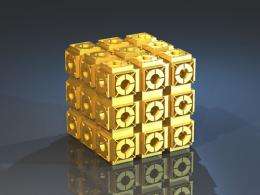Improving on the amazing: Scientists seek new conductors for metamaterials

(Phys.org) -- Scientists at the U.S. Department of Energy’s Ames Laboratory have designed a method to evaluate different conductors for use in metamaterial structures, which are engineered to exhibit properties not possible in natural materials. The work was reported this month in Nature Photonics.
Cloaking devices that hide planes from RADAR, microscopes that can see inside a single cell, and miniature antennae that measure only a few millimeters all sound like parts of a science fiction movie. But, within the span of the decade since they began their work, Ames Laboratory physicist Costas Soukoulis and his research team have moved these and other innovations from the realm of fiction closer to reality.
“Metamaterials have a few fundamentally new properties that may allow for many new applications,” said Soukoulis. For instance, natural materials refract light to the opposite side of the incidence normal, while metamaterials can refract light to the same side (left-handed materials), allowing imaging with a flat lens. Metamaterials are also capable of absorbing all light that hits them, reflecting none of it, creating perfect absorbers. The materials can even slow light. And what makes these properties even more interesting is that they can be adjusted to the needs of particular technologies.
“Usually, materials scientists are presented with a material, determine its properties and only then come up with a use for the material. But metamaterials work in the opposite direction,” said Soukoulis. “With metamaterials, we can think about what technology we’d like and what properties we want – perhaps properties unheard of before – and design the materials to exhibit those properties.”
Take, for example, the goal of creating super-efficient devices to harvest sunlight in solar energy products. Ideal materials for such a device would absorb 100 percent of the solar spectrum.
“In metamaterials, we can design both their magnetic and electric responses,” said Thomas Koschny, Ames Laboratory associate scientist. “Therefore, we can control the reflection at the interface of the metamaterial, which you cannot easily do in normal materials. In regular materials, particularly with the types of waves like light, materials have only an electric response, and they are always reflective. But, in a metamaterial, we can arrange the parts of the material so that the electric response equals the magnetic response, and the surface is reflection free and all waves go into the material.”
Other possible applications are “superlenses” that would allow us to use visible light to see molecules, like DNA molecules, in detail and devices that store large amounts of data optically. And many other potential uses exist because, unlike in natural materials, metamaterials can be designed to work at target frequencies, at least in principle, from radio frequencies to visible light.
But with such great potential also comes several challenges, some of which Soukoulis’ team have already made significant progress toward meeting. In 2006, the researchers were the first to fabricate a left-handed metamaterial, one with a negative index of refraction, in waves very close to visible light. In 2007, the group designed and fabricated the first left-handed metamaterial for visible light, and they recently fabricated chiral metamaterials that have giant optical activity.
Another challenge is reducing energy losses in metamaterials. Energy is lost by conversion to heat in their metallic components. In results reported in Nature Photonics this month, Soukoulis and his team evaluated a variety of conducting materials – including graphene, high-temperature superconductors and transparent conducting oxides.
“Graphene is a very interesting material because it is only a single atom thick and it is tunable, but unfortunately it does not conduct electrical current well enough to create an optical metamaterial out of it,” said Philippe Tassin, a postdoctoral research associate at Ames Laboratory. “We also thought high-temperature superconductors were very promising, but we found that silver and gold remain the best conductors for use in metamaterials.”
While neither graphene nor superconductors will immediately fix losses in metamaterials, Soukoulis’ work provides a method for evaluating future candidates to replace gold or silver that will help harness the enormous potential of metamaterials.
“Metamaterials may help solve the energy problems America is facing,” said Soukoulis. “There’s no shortage of new ideas in the field of metamaterials, and we’re helping make progress in understanding metamaterials’ basic physics, applied physics and possible applications.”
Provided by Ames Laboratory




















